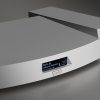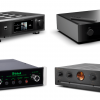Hack #3 from Home Theater Hacks by Brett McLaughlin (O’Reilly Media).
The Pitfalls of Chain Stores
Although it’s nice to listen to a specific set of speakers or audio components, in fact, most chain stores have huge rooms, with at least one glass wall, and you’re standing up—about as different from a typical home theater as you can get. So, although you will get an idea of the sound you would obtain at home, realize that it’s not a perfect picture of what to expect. If you want a closer-to-home experience, boutiques [Hack #4] often have viewing and listening rooms that closely simulate a home theater, with regular walls, only one door, low lighting, and even theater seating.
It’s also nice to be able to make sure the components you are buying are in perfect condition (even new equipment can easily be smudged or scratched in transit from the manufacturer). To really gain this advantage, though, be sure you insist on getting the specific model you are viewing rather than another unit already boxed up. You’ll also need to ensure that you don’t get stuck with a display unit that doesn’t have a remote, instructions, or other materials that should be included.
 chain stores often set up systems to favor the systems at the expense of the listeners. You won’t be sitting (or standing) in the exact same area, in the same size room, in your own home theater. Sometimes you can negotiate a lower price on a unit that has been demoed in the store; don’t be afraid to dicker, even at a chain store.
chain stores often set up systems to favor the systems at the expense of the listeners. You won’t be sitting (or standing) in the exact same area, in the same size room, in your own home theater. Sometimes you can negotiate a lower price on a unit that has been demoed in the store; don’t be afraid to dicker, even at a chain store.
You will avoid shipping charges, but these often are offset by sales tax, especially on larger purchases. If you’re buying more than $1,000 worth of gear, you’ll often break even in comparing local sales tax with shipping on nontaxed items. The only notable exception to this rule is larger TV sets, which typically cost a bundle to ship.
 There’s an ugly rumor going around that the days of buying tax-free across state lines are coming to an end. Although it might still be years before this comes into play nationwide, you might want to do some reading on the subject. The term for this is use tax–a tax on goods bought out of your state of residence, but intended to be used or consumed there. As an example, visit http://www.tax.ri.gov/info/whats.pdf to see what the State of Rhode Island expects from its citizens.
There’s an ugly rumor going around that the days of buying tax-free across state lines are coming to an end. Although it might still be years before this comes into play nationwide, you might want to do some reading on the subject. The term for this is use tax–a tax on goods bought out of your state of residence, but intended to be used or consumed there. As an example, visit http://www.tax.ri.gov/info/whats.pdf to see what the State of Rhode Island expects from its citizens.
It is also appealing to see your choices in movie and audio on a specific system. However, remain skeptical: as mentioned here and in Chapter 5, chain stores often ensure that systems are perfectly tuned with thousands of dollars of equalization, causing you to hear something more than just a receiver, speaker, or CD player. Assume that what you hear is the best possible case, not the average case.
Dress for the Best Service
Everyone pays more attention to people when they dress up, and no serious job applicant walks into an interview in old jeans and a ragged T-shirt. It’s obvious, at least in those cases, that although dress might not define you, at least it plays a part in identifying you. Dress can say you’re serious about a job, a person, even a purchase. It’s in this last category that a lot of ignorance lies. Taking the time to put on an outfit a few notches just below what you’d wear to a job interview will make a huge difference in the attention you get from qualified salespeople at home theater stores. Dress might not make as much of a difference in chain stores, but particularly in boutiques and other small shops, a well-dressed consumer will almost always get more attention, better information, and generally, a better deal. Ten extra minutes in the closet can result in hundreds of dollars saved, and a system that pleases you for years rather than months.
A Limited Inventory
Of course, it should go without saying that the biggest problem in chain stores is the lack of selection. You won’t see Marantz, Pioneer Elite, Onkyo, Meridian, Lexicon, B&K, and most other high-end component manufacturers in even the largest chain stores. This means you’re effectively limiting yourself to lower- to medium-ended manufacturers. If you’re on a shoestring budget, this might be acceptable, but if you’re looking for the best, you’ll want to investigate boutiques [Hack #4] and higher-end online sites [Hack #6].
When you shop in chain stores, realize this going in. If you’re looking for the very best in home theater, you’re probably going to leave frustrated and upset. If you’re on a tighter budget, though, you often can find some good buys. However, realize that any audiophile friends you have might turn up their noses at you. Don’t get in a tiff about this; you bought within your budget! Ask them how their credit card bills look, and then you can do the laughing.
 This material has been adapted from Home Theater Hacks by Brett McLaughlin, published by O’Reilly Media, Inc. Copyright O’Reilly Media, Inc., 2005. All rights reserved.
This material has been adapted from Home Theater Hacks by Brett McLaughlin, published by O’Reilly Media, Inc. Copyright O’Reilly Media, Inc., 2005. All rights reserved.
A smart collection of insider tips and tricks, Home Theater Hacks covers home theater installation from start to finish, purchase to experience. Just imagine: no frustrating trial and error process and better yet, no expensive appointments with installation experts. Home Theater Hacks prevents both by imparting down-and-dirty technique not found anywhere else.
Home Theater Hacks is available for purchase from Amazon.com, Amazon.co.uk, Amazon.ca and the sellers listed below.





























